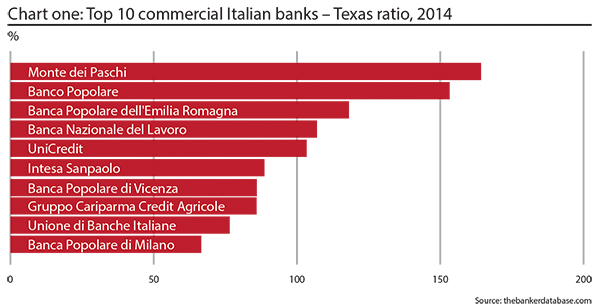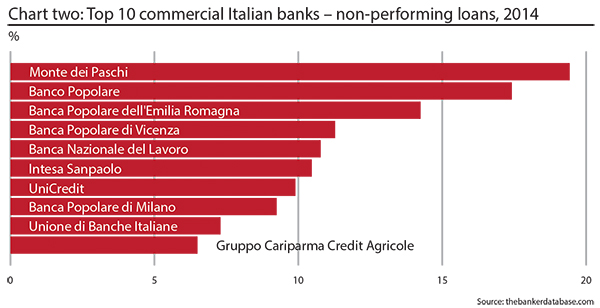While non-performing loans in Italy are at the historical peak, provisioning coverage is not.
According to Italy’s central bank, in March of this year, non-performing loans (NPLs) rose to a record EUR189.5bn. This is a 15% increase over March of the last year and although it marks a slowdown in the pace of NPL growth compared to 2014 it still is an unwelcome addition to the heap of problematic loans in Italy.
Bad loans have been rising at breakneck speed since 2009 in Italy, quadrupling in volume by March of 2015. A research paper by Nadege Jassaud and Kenneth Kang from the International Monetary Fund points out that this growth has not been matched by a proportional rise in provisions - in June of 2014 provisioning coverage was 42%, six percentage points lower than in 2007.
This mismatch will be challenging for banks to manage.
Kang and Jassaud warn that insufficient provisions prevent banks from writing NPLs off their balance sheets in a timely manner which can harm them, since keeping bad loans on the books for prolonged periods constrains new lending, as resources become tied up in servicing soured loans. High NPLs also increase funding costs and under extreme circumstances could even push a bank into insolvency.
Texas ratio
The Texas ratio (TR) is a useful method of gauging a bank’s solvency with respect to its non-performing loans and available funds. The ratio compares the book value of bad loans to total provisions and Tier 1 capital, showing the proportion of troubled assets to available capital. When the ratio exceeds 100%, the bank is no longer able to absorb the full extent of possible losses.
The top ten commercial Italian banks have average Texas ratio of 105%, with the highest figure being 164% at Monte dei Paschi and lowest being 67% at Banca Popolare di Milano.
Five lenders, Monte dei Paschi, Banca Popolare dell’Emilia Romagna (BPR), Banco Popolare, Banca Nazionale del Lavoro (BNL) and UniCredit, have ratios exceeding 100%.
As can be seen in chart one, Monte dei Paschi and Banco Popolare have the highest ratios, with Banco Popolare having a TR of 153%.
The other three banks have their ratios much closer to 100%, with BPR being highest at 118%.
However, banks with the highest TR had managed to reduce it from 2013 levels - Monte dei Paschi and Banco Popolare had Texas ratios of more than 180% year before. Monte dei Paschi accomplished this by raising EUR5.35bn in provisions and selling bad loan portfolios – the bank sold approximately EUR850mn worth of non-performing loans to Fortress, a U.S. private equity firm. Banco Popolare improved its safety cushion with a EUR1.75bn increase in provisions.
In contrast, UniCredit and BNL saw their ratios grow by respectively 20 and 17 percentage points, pushing them past the 100% threshold.
This happened as provisions fell by EUR9.73bn at Unicredit, while the stock of NPLs increased by EUR4.57bn. A similar situation took place at BNL, where bad loans grew by EUR1.35bn.
But, perhaps the most important trend to be found on balance sheets of Italian banks is that while NPLs ballooned over the last six years, the overall volume of loans plateaued. At all top ten commercial banks but Gruppo Cariparma, total loans decreased in 2014, while toxic loans grew both in relative and absolute terms.




